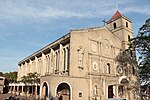Asia-Pacific Nazarene Theological Seminary
1983 establishments in the PhilippinesAsia-Pacific Nazarene Theological SeminaryEducational institutions established in 1983Free Methodist ChurchProtestant schools in the Philippines ... and 4 more
Seminaries and theological colleges in the PhilippinesWesleyan ChurchWikipedia external links cleanup from February 2017Wikipedia spam cleanup from February 2017
Asia-Pacific Nazarene Theological Seminary (APNTS) is a graduate-level theological institution located near Metro Manila in the Philippines. APNTS is a seminary in the Wesleyan theological tradition and affiliated with the Church of the Nazarene through its Division of World Mission. Its mission is to prepare "men and women for Christ-like leadership and excellence in ministries." Its institutional vision is: "Bridging cultures for Christ, APNTS equips each new generation of leaders to disseminate the gospel of Jesus Christ throughout Asia, the Pacific, and the world.
Excerpt from the Wikipedia article Asia-Pacific Nazarene Theological Seminary (License: CC BY-SA 3.0, Authors).Asia-Pacific Nazarene Theological Seminary
Liwayway Hills,
Geographical coordinates (GPS) Address Website External links Nearby Places Show on map
Geographical coordinates (GPS)
| Latitude | Longitude |
|---|---|
| N 14.577649 ° | E 121.145575 ° |
Address
Asia Pacific Nazarene Theological Seminary
Liwayway Hills
1920
Rizal, Philippines
Open on Google Maps







